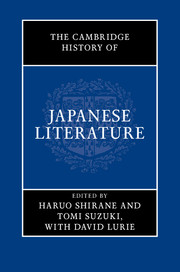24 results
Index
-
- Book:
- The Cambridge History of Japanese Literature
- Published online:
- 05 January 2016
- Print publication:
- 17 December 2015, pp 821-847
-
- Chapter
- Export citation
Part I - The ancient period (beginnings to 794)
-
- Book:
- The Cambridge History of Japanese Literature
- Published online:
- 05 January 2016
- Print publication:
- 17 December 2015, pp 13-92
-
- Chapter
- Export citation
14 - ThePillow Bookof Sei Shōnagon
- from Part II - The Heian period (794–1185)
-
-
- Book:
- The Cambridge History of Japanese Literature
- Published online:
- 05 January 2016
- Print publication:
- 17 December 2015, pp 161-164
-
- Chapter
- Export citation
21 - Introduction to medieval literature
- from Part III - The medieval period (1185–1600)
-
-
- Book:
- The Cambridge History of Japanese Literature
- Published online:
- 05 January 2016
- Print publication:
- 17 December 2015, pp 211-217
-
- Chapter
- Export citation
Acknowledgements
-
- Book:
- The Cambridge History of Japanese Literature
- Published online:
- 05 January 2016
- Print publication:
- 17 December 2015, pp xvii-xvii
-
- Chapter
- Export citation
Illustrations
-
- Book:
- The Cambridge History of Japanese Literature
- Published online:
- 05 January 2016
- Print publication:
- 17 December 2015, pp xiii-xiii
-
- Chapter
- Export citation
28 - Setsuwa (anecdotal) literature:Nihon ryōikitoKokon chomonjū
- from Part III - The medieval period (1185–1600)
-
-
- Book:
- The Cambridge History of Japanese Literature
- Published online:
- 05 January 2016
- Print publication:
- 17 December 2015, pp 280-286
-
- Chapter
- Export citation
Contributors
-
- Book:
- The Cambridge History of Japanese Literature
- Published online:
- 05 January 2016
- Print publication:
- 17 December 2015, pp xiv-xvi
-
- Chapter
- Export citation
A note on Romanization and conventions
-
- Book:
- The Cambridge History of Japanese Literature
- Published online:
- 05 January 2016
- Print publication:
- 17 December 2015, pp xviii-xviii
-
- Chapter
- Export citation
Part IV - The Edo period (1600–1867)
-
- Book:
- The Cambridge History of Japanese Literature
- Published online:
- 05 January 2016
- Print publication:
- 17 December 2015, pp 371-550
-
- Chapter
- Export citation
Copyright page
-
- Book:
- The Cambridge History of Japanese Literature
- Published online:
- 05 January 2016
- Print publication:
- 17 December 2015, pp iv-iv
-
- Chapter
- Export citation
Glossary
-
- Book:
- The Cambridge History of Japanese Literature
- Published online:
- 05 January 2016
- Print publication:
- 17 December 2015, pp xix-xx
-
- Chapter
- Export citation
38 - Introduction to early modern Japanese literature
- from Part IV - The Edo period (1600–1867)
-
-
- Book:
- The Cambridge History of Japanese Literature
- Published online:
- 05 January 2016
- Print publication:
- 17 December 2015, pp 373-381
-
- Chapter
- Export citation
General introduction
-
-
- Book:
- The Cambridge History of Japanese Literature
- Published online:
- 05 January 2016
- Print publication:
- 17 December 2015, pp 1-12
-
- Chapter
- Export citation

The Cambridge History of Japanese Literature
-
- Published online:
- 05 January 2016
- Print publication:
- 17 December 2015
Part V - The modern period (1868 to present)
-
- Book:
- The Cambridge History of Japanese Literature
- Published online:
- 05 January 2016
- Print publication:
- 17 December 2015, pp 551-767
-
- Chapter
- Export citation
41 - The rise of haikai: Matsuo Bashō, Yosa Buson, and Kobayashi Issa
- from Part IV - The Edo period (1600–1867)
-
-
- Book:
- The Cambridge History of Japanese Literature
- Published online:
- 05 January 2016
- Print publication:
- 17 December 2015, pp 403-414
-
- Chapter
- Export citation
51 - Satiric poetry: Kyōshi, Kyōka, and Senryū
- from Part IV - The Edo period (1600–1867)
-
-
- Book:
- The Cambridge History of Japanese Literature
- Published online:
- 05 January 2016
- Print publication:
- 17 December 2015, pp 503-509
-
- Chapter
- Export citation
Contents
-
- Book:
- The Cambridge History of Japanese Literature
- Published online:
- 05 January 2016
- Print publication:
- 17 December 2015, pp v-xii
-
- Chapter
- Export citation
Part III - The medieval period (1185–1600)
-
- Book:
- The Cambridge History of Japanese Literature
- Published online:
- 05 January 2016
- Print publication:
- 17 December 2015, pp 209-370
-
- Chapter
- Export citation

